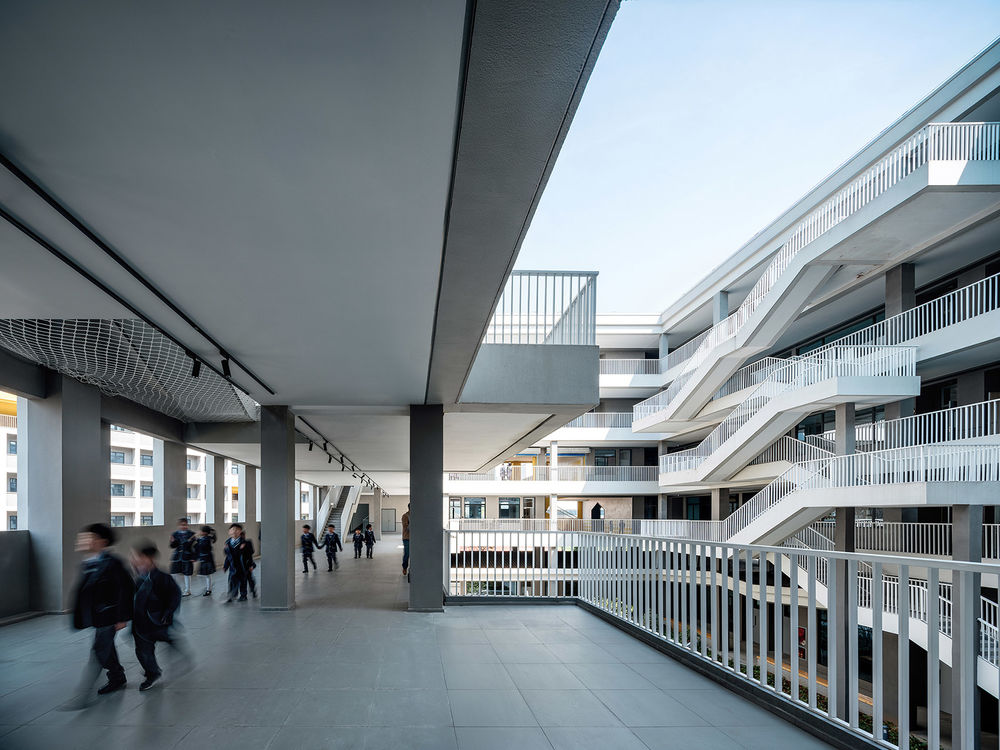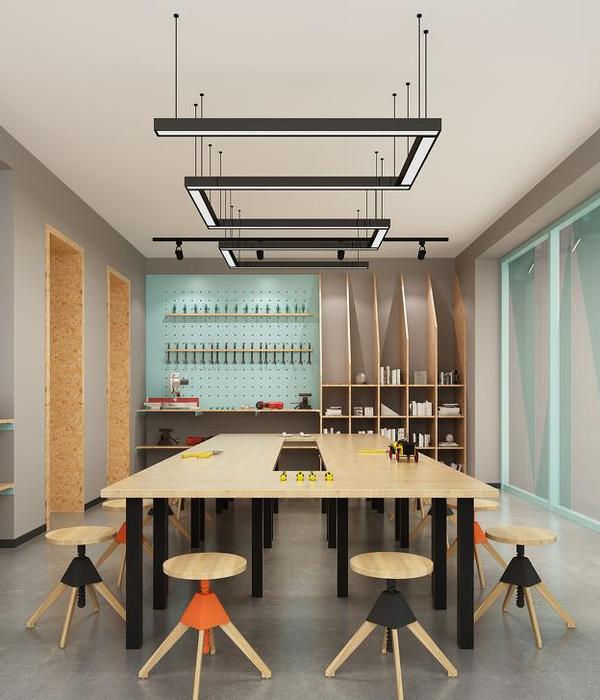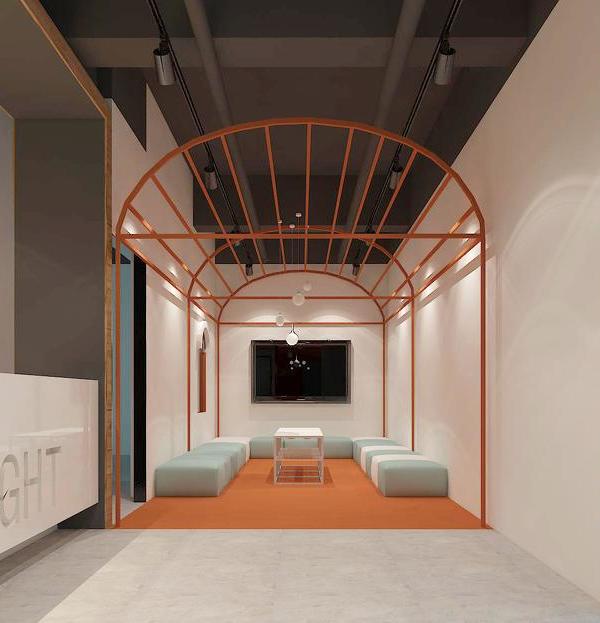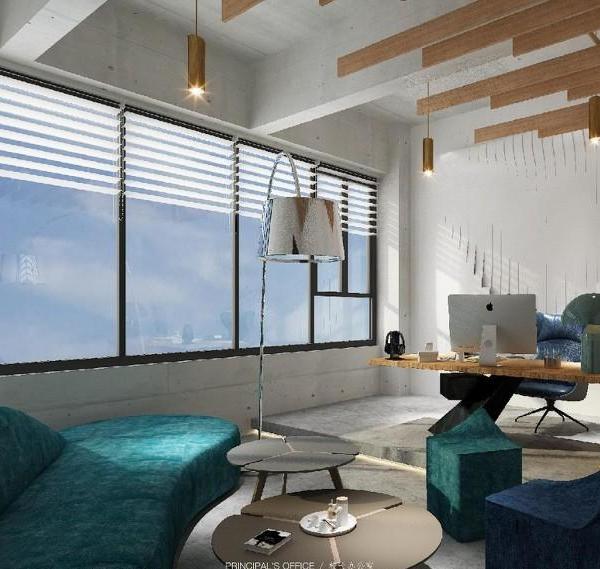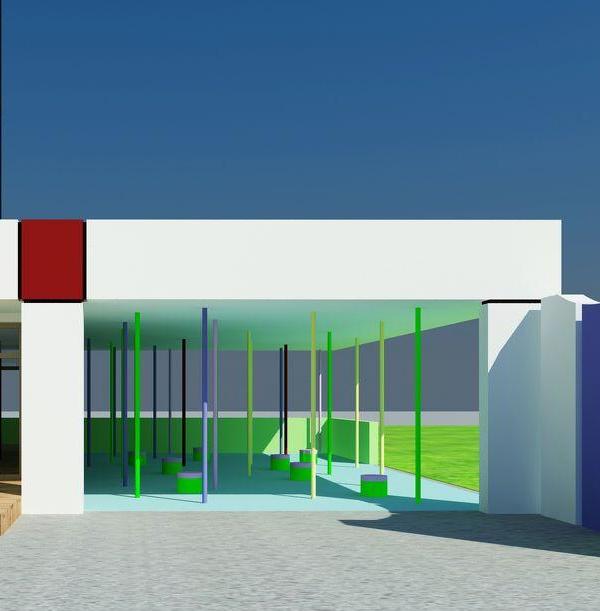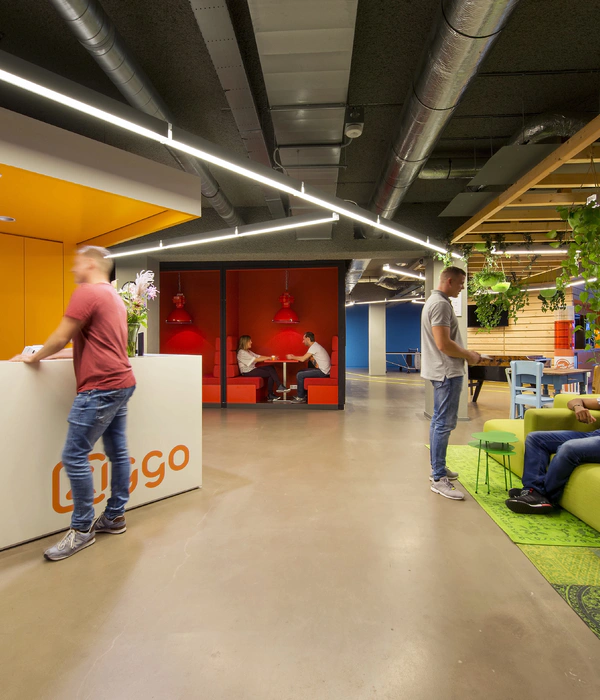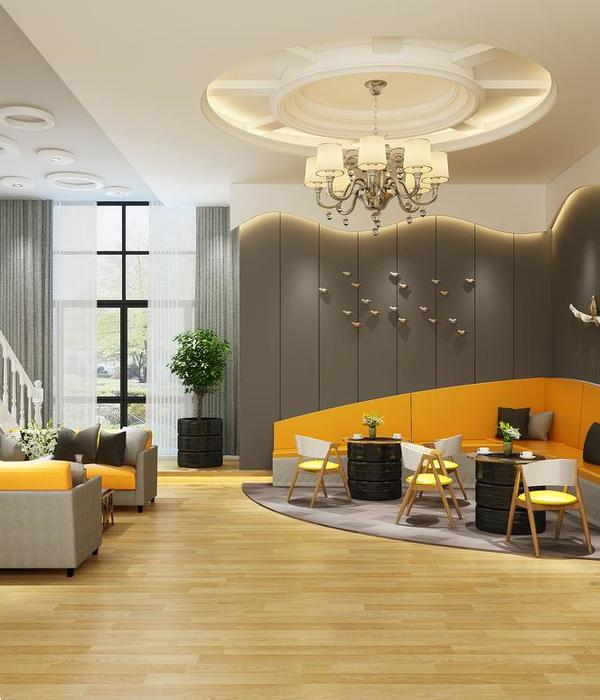义乌新世纪外国语学校,浙江 / 零壹城市建筑事务所
由零壹城市建筑事务所(LYCS Architecture)从2016年开始设计的义务新世纪外国语学校如今已投入使用,也刚结束了它的第一学期。
这个位于浙江省义乌市主城区的学校是杭州新世纪外国语学校的分校,共有48个班的小学与24个班的初中。
它作为侨商回国的开篇之作,也是零壹城市一直以来持续关注与探究的高密度城市与教学空间设计问题的典型实践之一。
Yiwu Foreign Languages School, designed by the LYCS Architecture, is now in use and has just completed its first semester. It is located in the main urban area of Yiwu, Zhejiang Province, with 48 classes of elementary schools and 24 classes of junior high schools. As the first project of returned overseas Chinese, it’s also one of the typical practices of teaching space design issues Comfort scale in high density urban that have been continuously researched by LYCS Architecture.
▼校园教学楼外观,exterior view of the school building

走进义乌新世纪外国语学校,整体设计所呈现出的是一个富有亲切感,充满童趣和探索欲望的校园,以孩子的视角为出发点,引入“走读式”、“社区式”和“社会式”的教学环境,激发孩子们的学习热情和创造力,也是一个兼备义乌本土根基和国际化视野的舒适校园。
The design is aimed to create a joyful campus to bring back a sense of intimacy and inspire children’s curiosity, rather than a uniform and solemn general school. Starting with a child’s perspective, the design introduces the “moving”, “communal” and “social” teaching environment to stimulate children’s desire for study and creativity. It’s also a comfortable campus integrated with the international outlook and Yiwu-rooted culture.
▼主入口视角,main entrance view
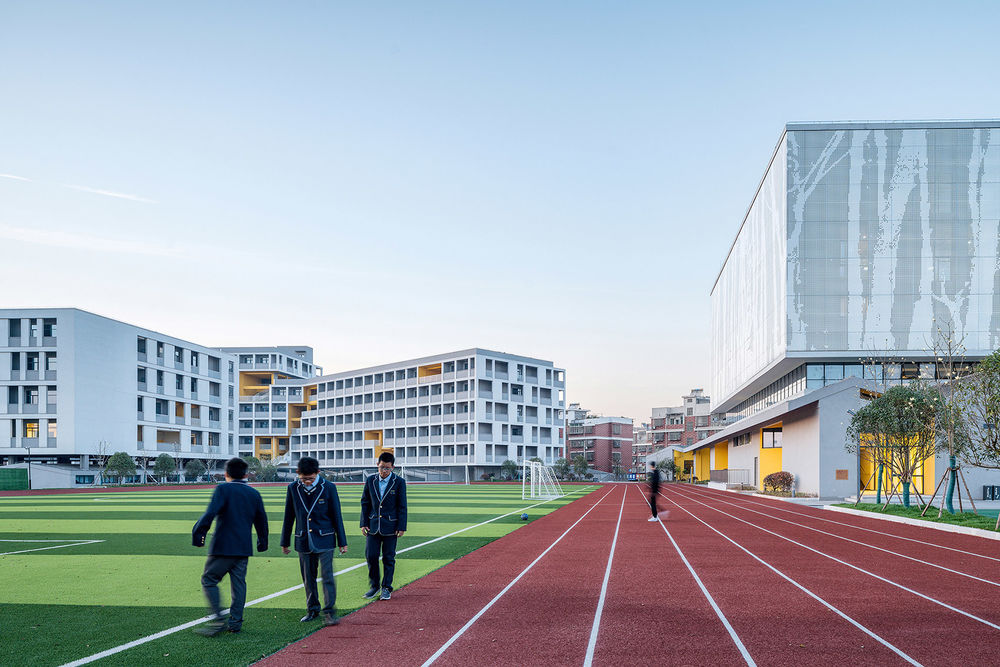
▼教学楼和宿舍楼西南人视, southwest view of school and dormitory
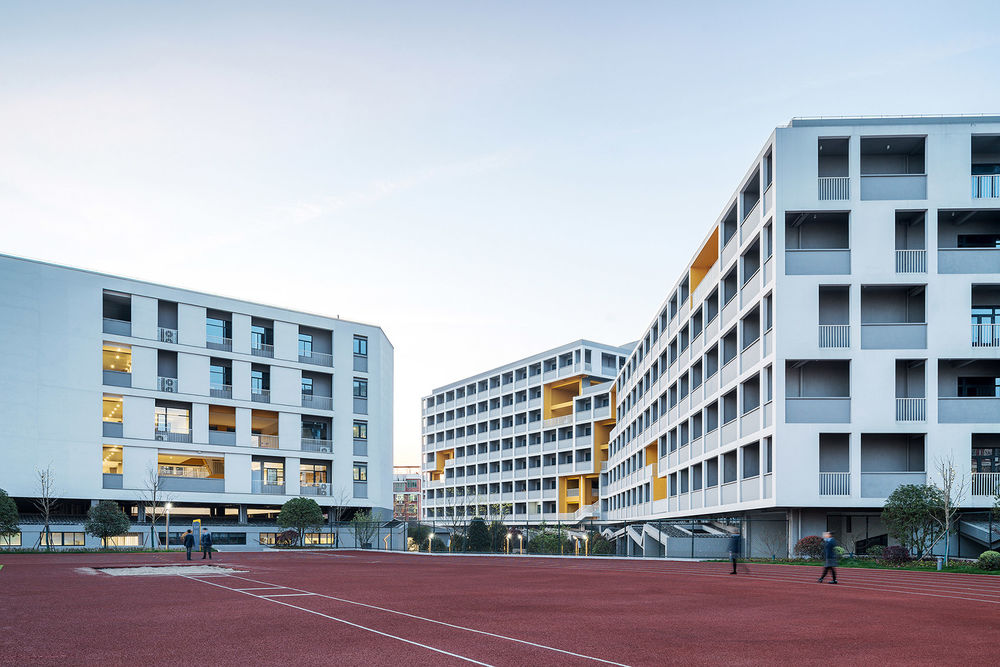
A.M. 8:00丨入校 A. M. 8:00丨Go to School
高密度环境下的舒适尺度|Comfort Campus in High Density Urban
整个校园场地是一个呈45度朝向的矩形,建筑密度达到1.4,远超0.8的平均标准,场地空间利用非常紧张。如此高密度环境下的校园建筑规划设计,是一场空间的游戏也是一道数学题:通过规划的布局最终满足一个容积率的等式。解开这道“数学题”的同时又能满足校园亲切舒适的尺度成为了规划的核心问题。
The site is a rectangle rotated at a 45-degree angle. Compared with other normal schools of similar scale, the site space is very limited, with a high plot ratio of 1.4 instead of 0.8 of others. Campus architecture planning in such a high-density environment is a space game and a math problem: the layout of the plan finally meets a plot of the floor area ratio. Solving this "mathematical problem" while meeting the scale of the campus’s intimate comfort has become the core issue of planning.
▼首层平面图,ground floor plan

聚焦这一问题,设计首先对学校的功能和体量进行分析,并整理出每一个教学单元和空间模块,然后将各个教育用房单元根据自身所需的日照、采光、通风以及朝向条件进行合理高效的布置和摆放。 公共教学用房以及校园公共空间铺开布置在首层,以使校园公共活动更多的在首层发生; 教学楼、宿舍和风雨操场等建筑体量布置在二层及以上,以保证良好的日照、采光和通风。 这样的布置的策略是将大量同质化的教学单元集中布置,将节约下来的土地空间留给公共教学单元和公共空间,这也与新世纪外国语学校的小外交官教学体系高度契合。
The design addresses this issue with a series of design process. Each teaching units and spatial module are derived from analyzing about function and volume. Then, the teaching units are organized in a rational and efficient layout, each specially adapted to meet the requirement of the sunlight and ventilation.
Ultimately, the program is generated into two parts. Public space is stretched over the ground floor to stimulate more campus activities. While classrooms, dormitories, playground and other volumes are built on the second floor and above to ensure sufficient sunlight and ventilation.
Therefore, the planning strategy not only compact numerous homogeneous space to save more for public, but also fits in the diplomatic concept of educational system.
▼公共教学用房以及校园公共空间铺开布置在首层; 教学楼、宿舍和风雨操场等建筑体量布置在二层及以上, public space is stretched over the ground floor; classrooms, dormitories, playground and other volumes are built on the second floor and above.

A.M. 10:00丨课堂与课间 A.M. 10:00丨Class & Break
本土根基与国际视野的有机融合|Organic Integration of Local Roots and International Vision
学校所在的城市义乌作为全球最大的小商品集散中心,被联合国与世界银行等权威机构誉为世界第一大市场。在兼具本土根基与国际视野的大环境下,新世纪外国语学校同样也有着传统国学文化与国际化教学体系兼容并重的教育理念,那么建筑空间如何应对理念所需的教学空间要求成为设计聚焦的又一个问题。
As the world’s largest wholesale market of commodities, Yiwu is praised as the largest market by the United Nations and the World Bank. In such a city with both local and international perspectives, how architectural space meet the need for new teaching space type combined the international education system and traditional culture.
▼轴测图首层局部特写,ground floor axonometric drawing

在教学空间的设置上,在基本的公共教室和实验室之外,首层还设有阅览室、音乐报告厅、艺术沙龙、舞蹈室、美术教室、书法教室、专家交流中心、校史馆、画廊等功能。并且各个功能被有机的结合在一起,以院落为中心集中布置,形成知识之院、科技之院、人文之院、艺术之院等主题空间。
与此同时,为了整体打造校园环境,设计从空间结构、人造物与自然物的角度出发,将建筑、室内和景观融合在一起,达到一种“浸润式”的教学空间体验。
On the ground floor, there are laboratories and public classrooms, including other functional spaces including reading rooms, the concert hall, art lounge, dance rooms, art rooms, calligraphy rooms, the experts communication center, the school history room and gallery. These diverse spaces are bonded organically, and centered with courtyards to form thematic courtyards themed with “ knowledge”, “science”, “culture” and “art”. At the same time, the design creates an integral environment, from the perspective of spacial structure, artifact and nature. And the “immersed” teaching space experience is achieved by blurring the boundary of architecture, interior and landscape.
▼教学空间以院落为中心集中布置,形成知识之院、科技之院、人文之院、艺术之院等主题空间。Those diverse spaces of teaching area are bonded organically, and centered with courtyards to form thematic courtyards themed with “knowledge”, “science”, “culture” and “art”.
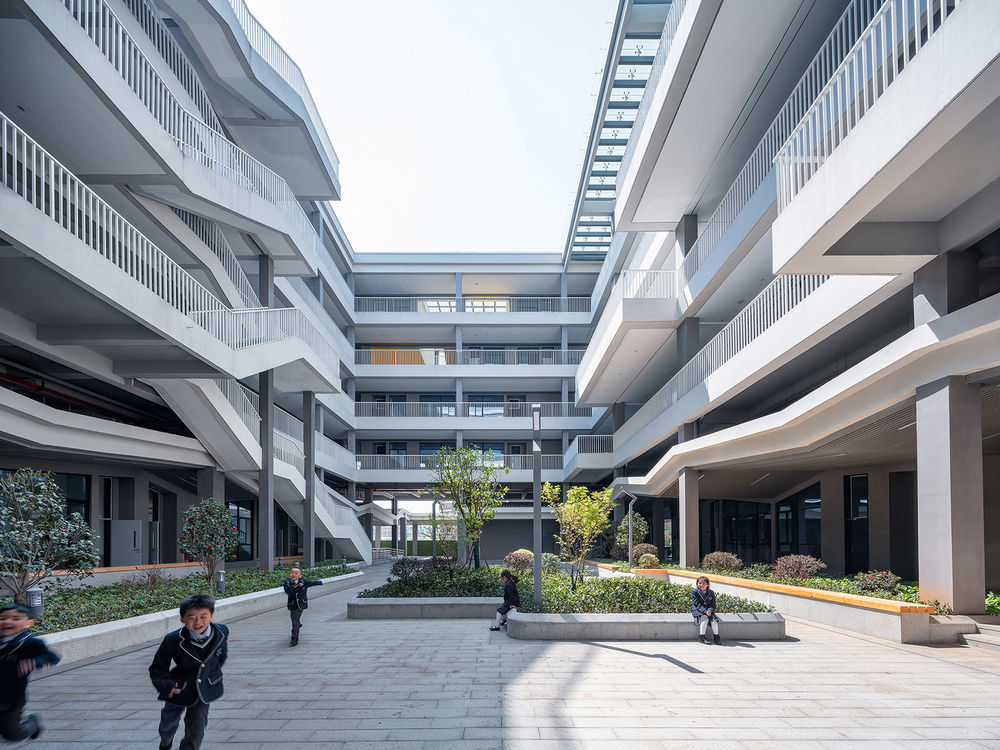
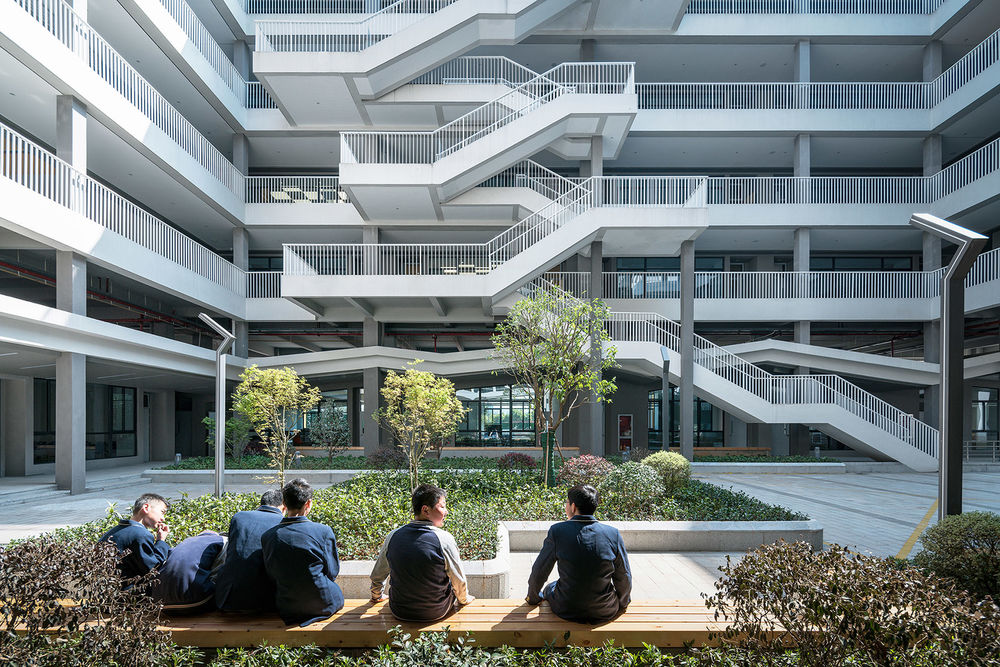
▼活动室空间,activity room
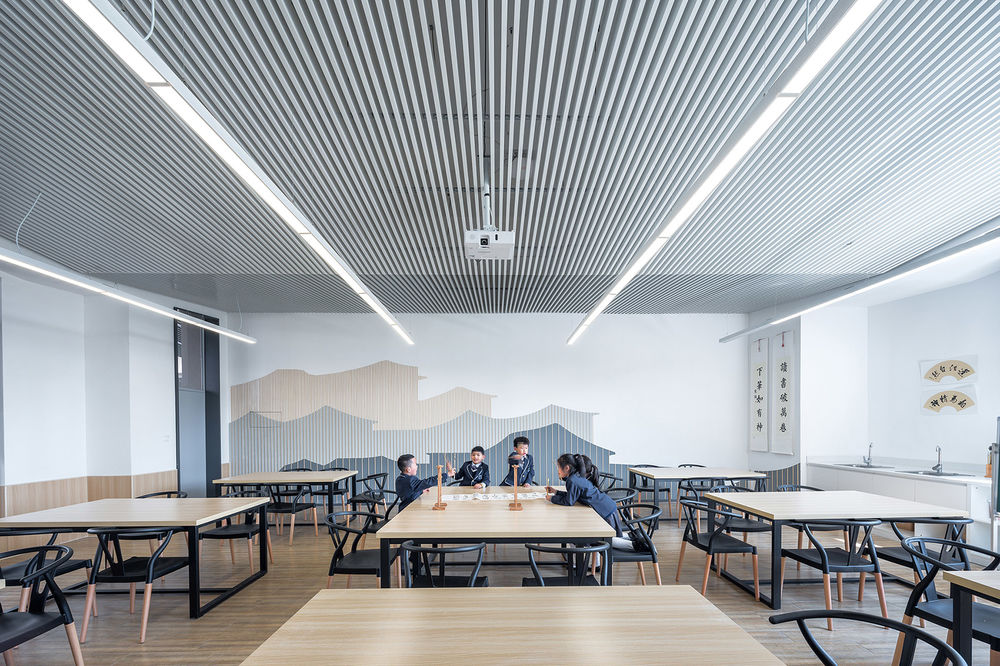
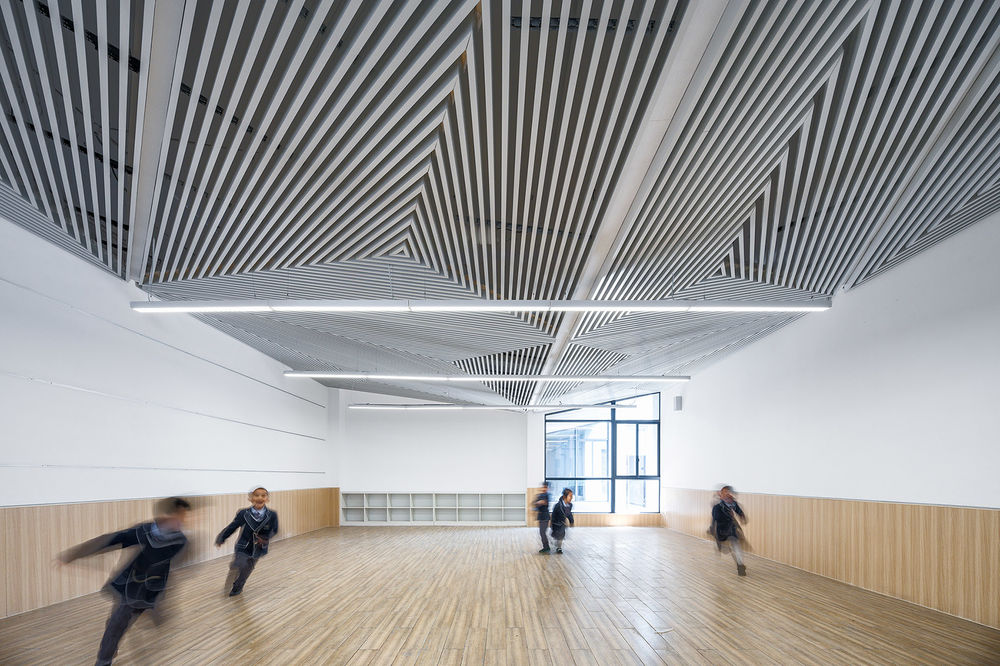
A.M. 12:00丨午间 A.M. 12:00丨Lunch Time
国际学术交流中心包含了教师办公、教育培训以及少量餐饮空间,建筑高度达45米;风雨操场可容纳两个标准篮球场,丰富学校的体育运动功能。将国际化与本土化所需要的教学空间有机结合。
The international academic exchange center includes offices, training space and a small amount of dining room, with the height of 45 meters. The playground can serve as two standard basketball courts to enrich the sport activities. The design combines the teaching space required for internationalization and localization.
▼风雨操场室内空间,interior space of the playground
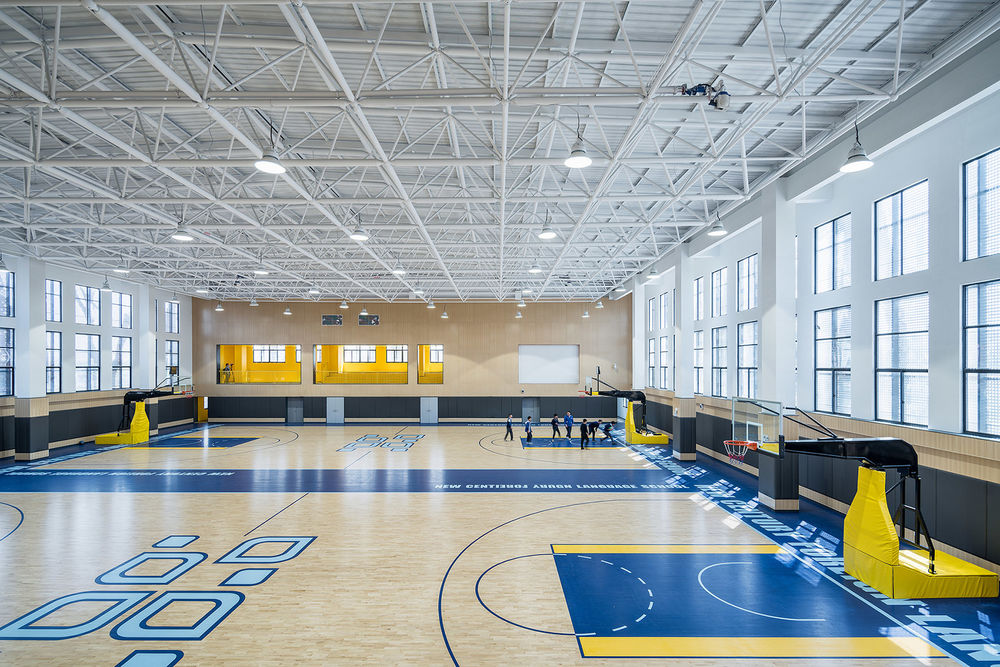
▼临近风雨操场的餐饮空间,canteen near the playground
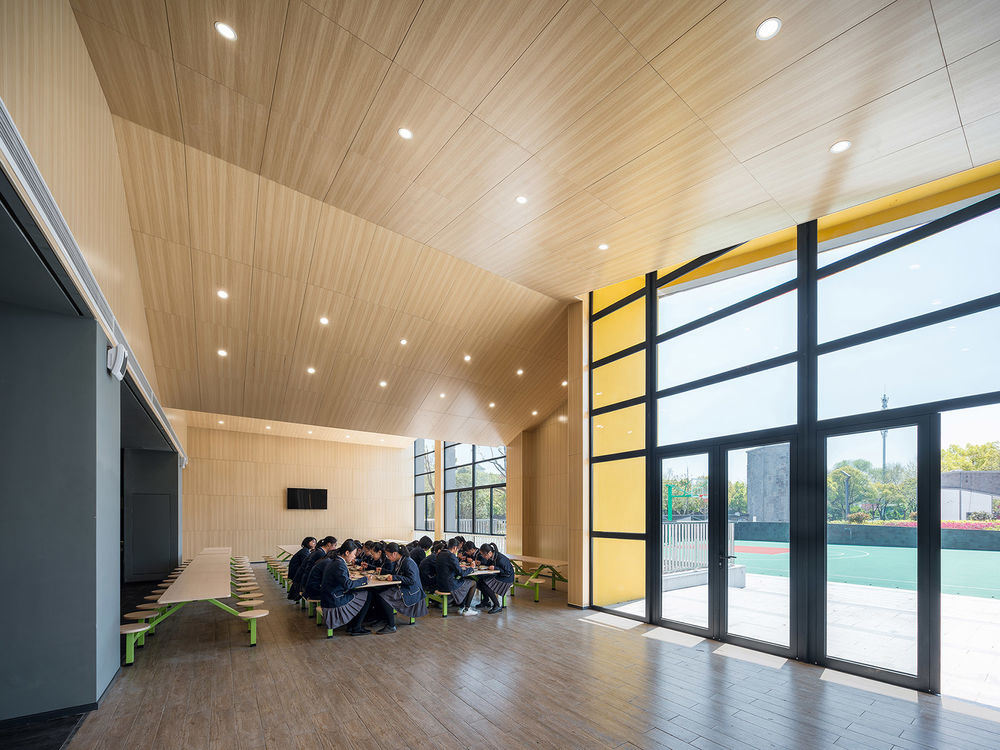
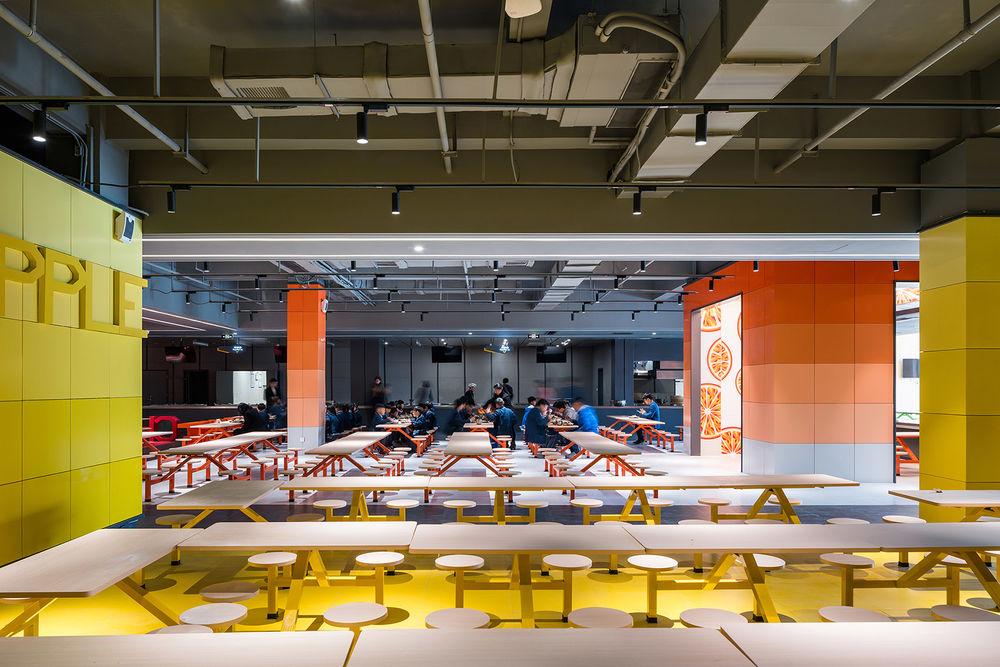
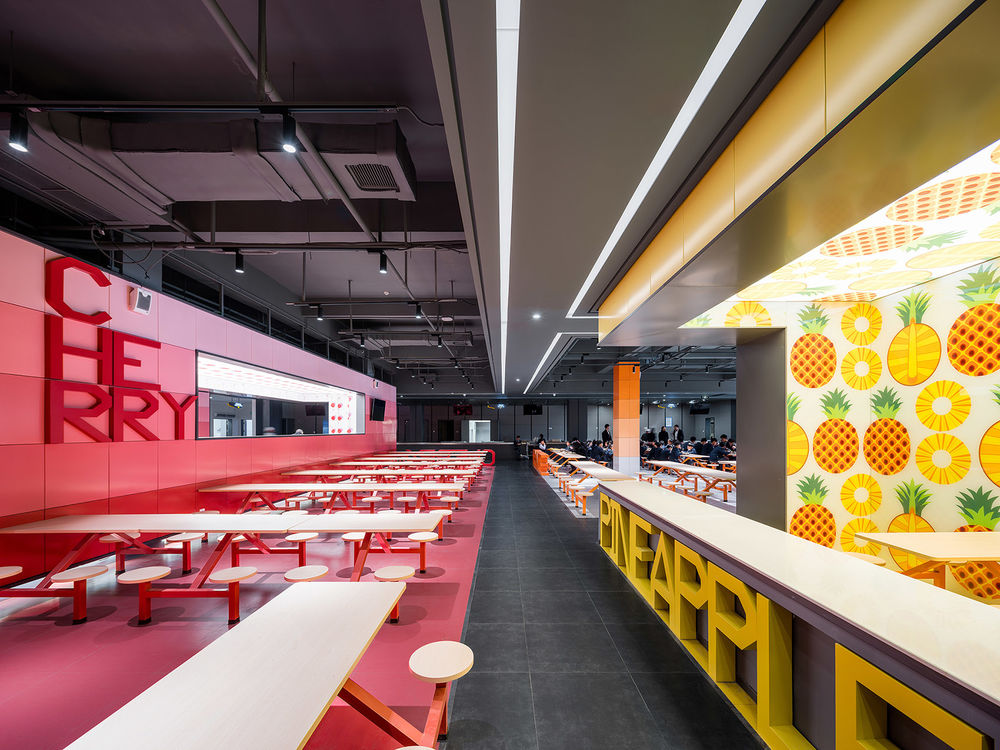
此外,设计在教室与地面集中活动场地之间创造了中间层级的活动场地,让课间短暂的时间也能让学生充分玩耍。把教学楼和宿舍楼局部的体块掏空形成半开放的活动空间,将掏空与开洞这种二维的建筑元素增加了一维,表面上看是把原有的实体空间减少了一部分,实则掏空的部分成为了学生课外活动、接触自然的场所,增加了整体空间的丰富程度,反而达到了100-1=101的效果。并且,活动空间被设计为统一的明黄色,配合午间阳光的光影效果,为校园增添活力的同时增强辨识度与归属感,促进学生们的沟通交流。
▼教学楼活动空间-设计在教室与地面集中活动场地之间创造了中间层级的活动场地,让课间短暂的时间也能让学生充分玩耍, school activity space-designers created a second level of activity space between classroom and ground activity space, allowing students to play for a 10 minutes break.
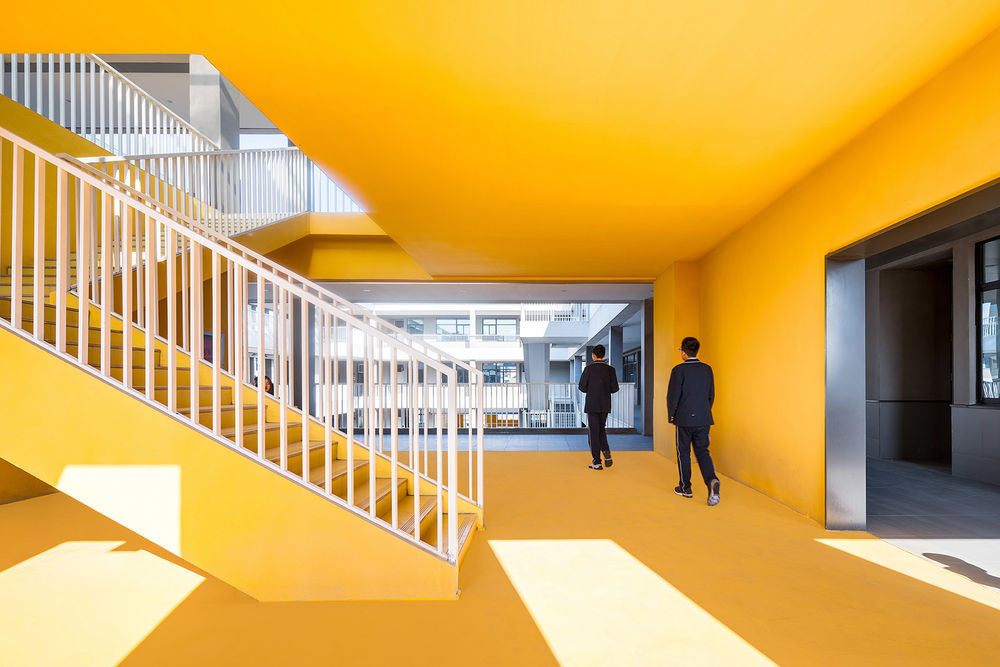
▼宿舍楼活动空间,dormitory activity space
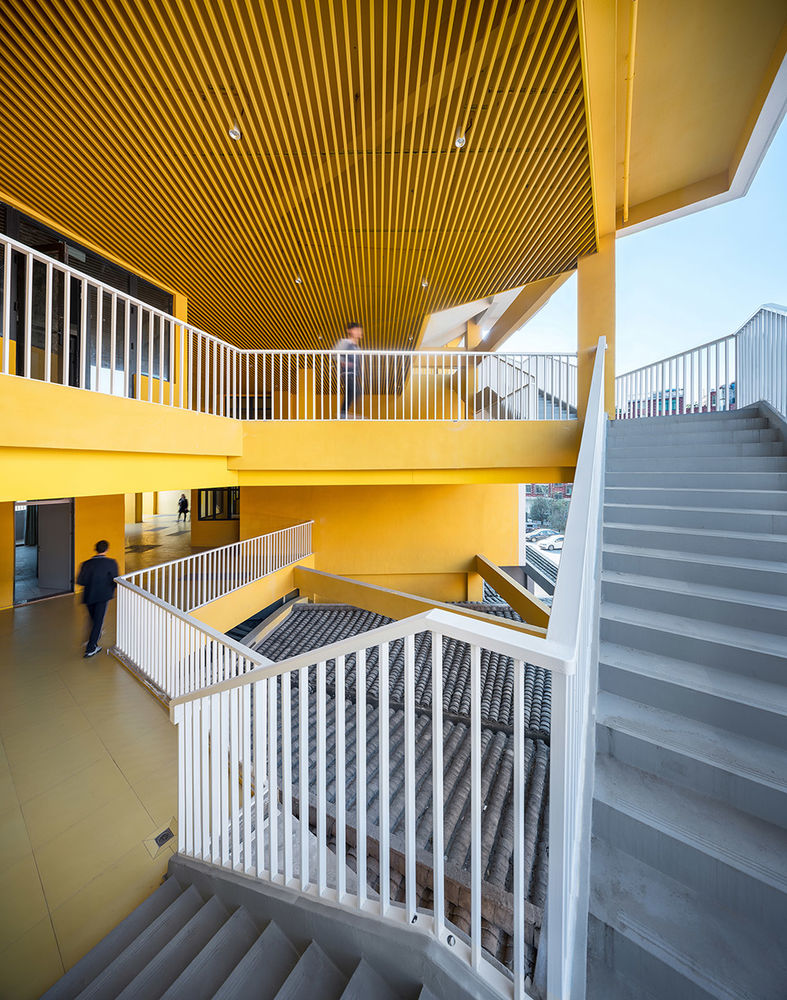
▼活动空间被设计为统一的明黄色, all event spaces are designed to be bright yellow
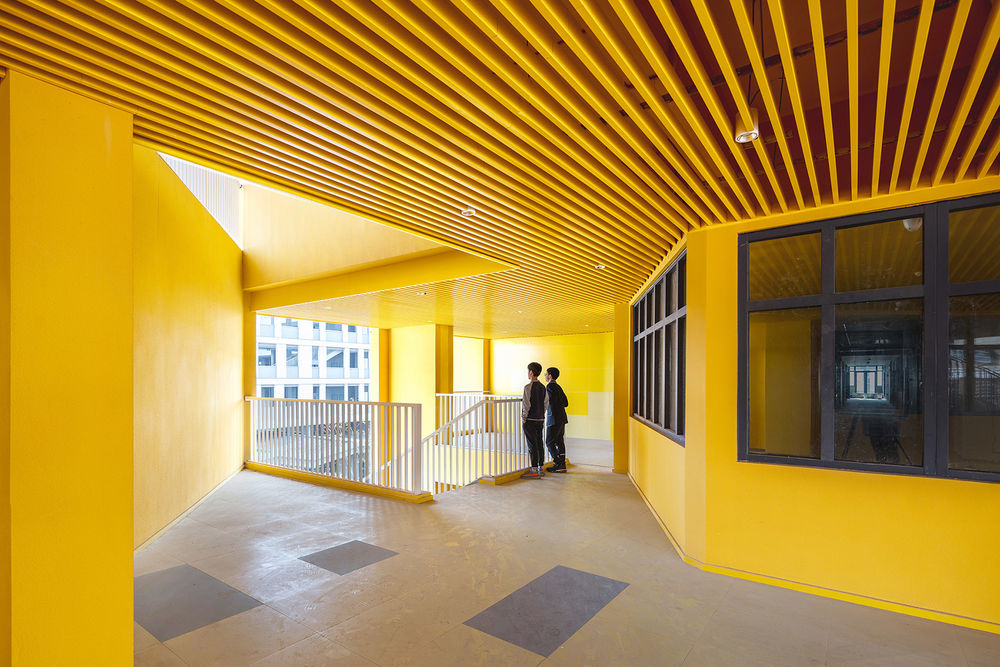
P.M. 4:30丨户外活动 P.M. 4:30丨Outdoor Sports
以小胜大的社区式校园|Miniature City Campus from Small-scale
学校的老师们认可并且提倡教育不仅仅局限在教室空间内,走道、操场等都可以成为学习的空间,这个范围甚至可以扩大到城市中的街道、巷弄、院子、广场、公园等,让孩子们通过融入社区去自我学习和成长,在整体的经历和个人意识的逐渐形成中,个体能去和公众生活乃至社会发生接触,而这方面的教育是不能直接教授的。为此,校园中的教育活动场所不应仅着眼于教室,而是以城市规划的视野作为出发点。校园首层的建筑形态以当地江南水乡的坡屋顶建筑为原型进行排列组合,并置入了“街道”、“巷弄”、“院子”、“口袋公园”等有趣友好的场所,强化校园的“社区感”,“大街小巷”之间互相连通,并连接着一个个小而美、小而亲的场所,生态开放,恬静安逸,为孩子们带来“浸润式”的教学空间体验,引发孩子们互动玩耍、学习交流的热情。
▼首层“巷弄”活动空间,ground floor ‘lanes’
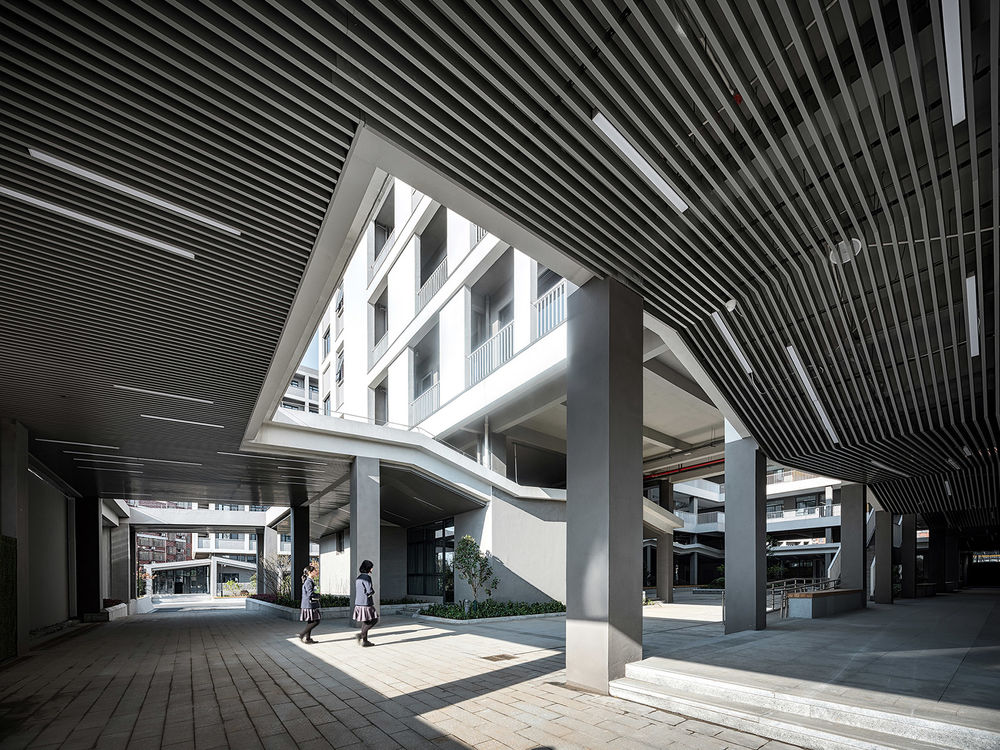
▼“口袋公园”活动空间,school ‘pocket parks’
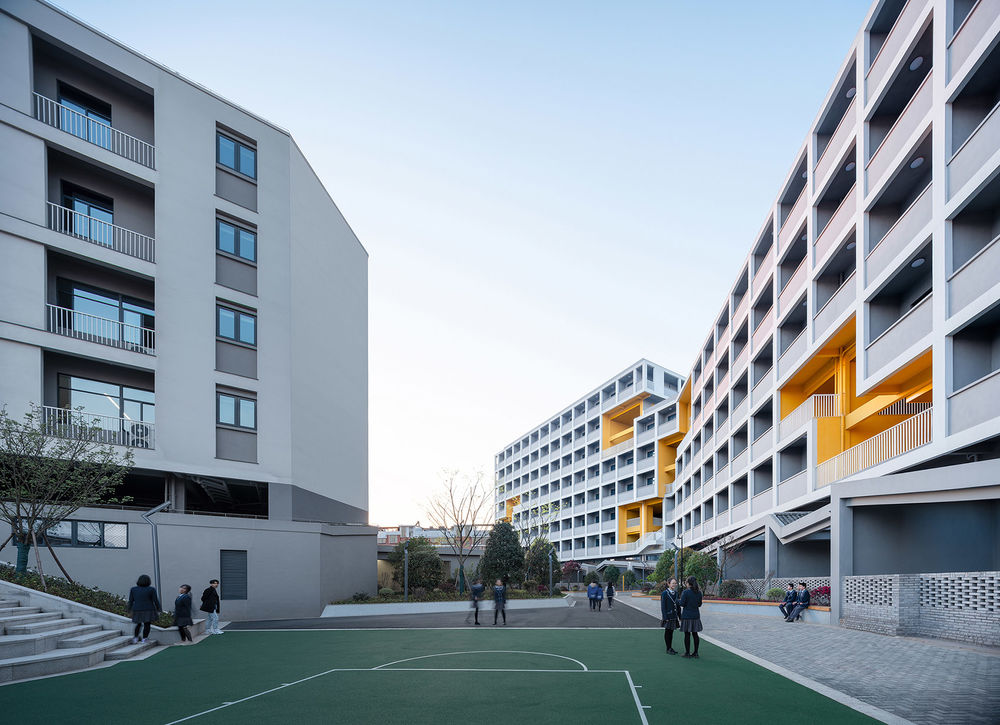
▼“街角公园”活动空间,school ‘corner parks’
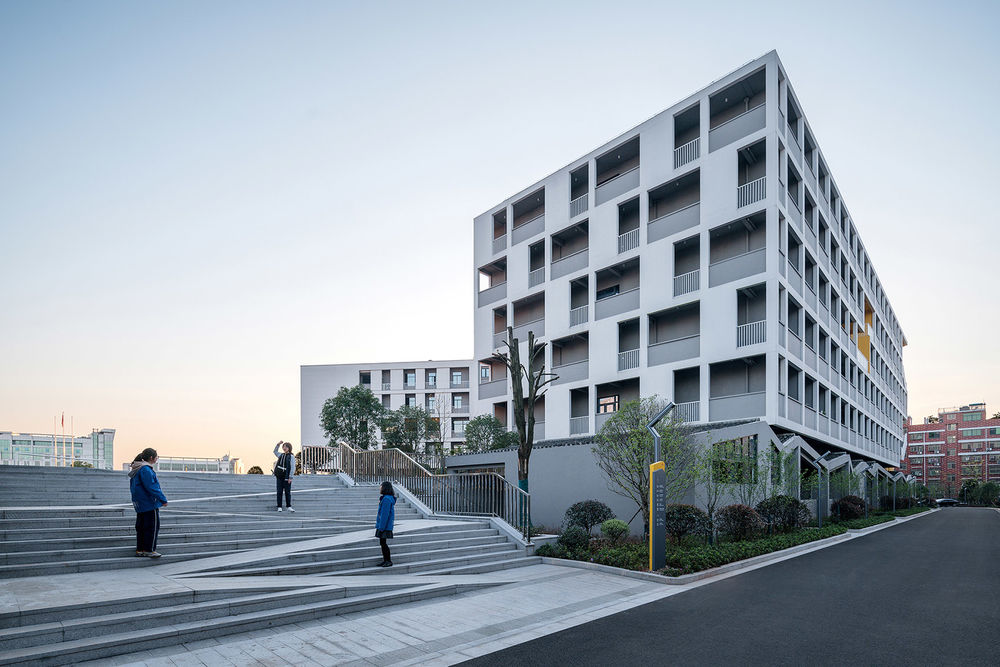
P.M. 6:00丨 放学 P.M. 6:00丨 Out of School
追寻面向未来的传统空间体验|Pursue Traditional Space Experience for Creation
校园首层裙房的折面屋顶铺满了小青瓦,是中国传统建筑中最常见的一种材料之一。从上层建筑向外眺望就可以看到,瓦片不仅起到建筑屋面保温防水的作用,还为整个校园带来了一份优雅和淡然。
校园内的场地东北侧和西南侧的标高有着3-4米的高差,屋顶的折面巧妙的结合了地形,在高差最明显的地方屋顶与地面相连,使人能够直接漫步到裙房的屋顶,感受到层层叠叠的瓦片所带来的时间沉淀后的痕迹和感染力。材料和形式上的创新设计和面向未来的处理手法却能够将人带入到本土化的传统空间体验。
The pitched roofs of the podiums are clad with grey tiles, one of the most common traditional Chinese building materials. Once looking out from the upper buildings, it could be obviously seen that the tiles not only function as heat preservation and water resistance for the roof, but also bring about a trace of elegance and tranquility to the entire campus.
The height difference between northeastern end and southwestern end of the campus is about three-four meters. The folding roof descends to the ground to subtly combine with the topography, in the place with the most apparent height difference. People could directly wander on the roof of the podiums and perceive the trace and appeal of time passing, which is brought about by layering tiles.
▼校园首层裙房的折面屋顶铺满了小青瓦,屋顶的折面巧妙的结合了地形。The pitched roofs of the podiums are clad with grey tiles. The folding roof descends to the ground to subtly combine with the topography.
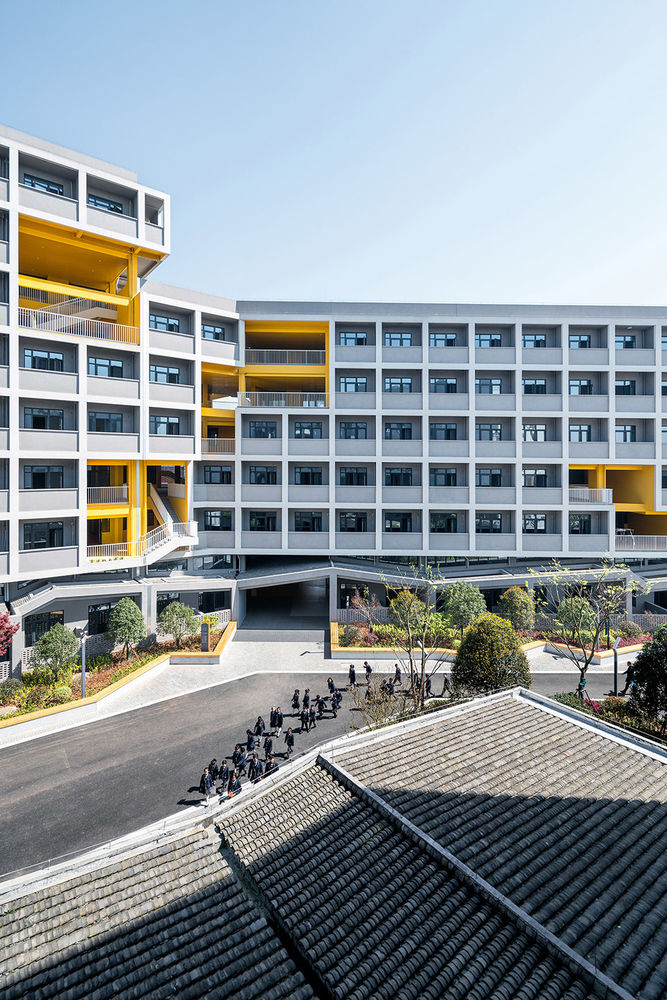
▼瓦片不仅起到建筑屋面保温防水的作用,还为整个校园带来了一份优雅和淡然。It could be obviously seen that the tiles not only function as heat preservation and water resistance for the roof, but also bring about a trace of elegance and tranquility to the entire campus.

一天即将落幕,在校园首层漫步时可以通过院子强烈的感受到上层建筑的存在。首层裙房的各个院子呼应着上层建筑的形态,虽然二者有着不尽相同的尺度,但上与下仍有着一种几何和视觉上的张力。它们之间建立起的一种微妙的视觉关系,让上层建筑像是漂浮在“瓦海”上“指航灯”一样,为校园带去明确的空间指向性,两者唇齿相依,相得益彰。
A subtle visual relationship is generated between the upper buildings and podiums. Upper buildings are seemed as the “lighthouses” floating on the “sea of tiles”, forming clear spatial orientation for the campus.
The courtyards are echoing the form of upper buildings, which are correlated closely with each other. Therefore, in the journal of walking in the courtyards, people could feel strongly the existence of the upper buildings.
Moreover, geometric and visual tension penetrate through the upper and lower space, despite their different levels of scale.
▼上层建筑像是漂浮在“瓦海”上“指航灯”, upper buildings are seemed as the “lighthouses” floating on the “sea of tiles”
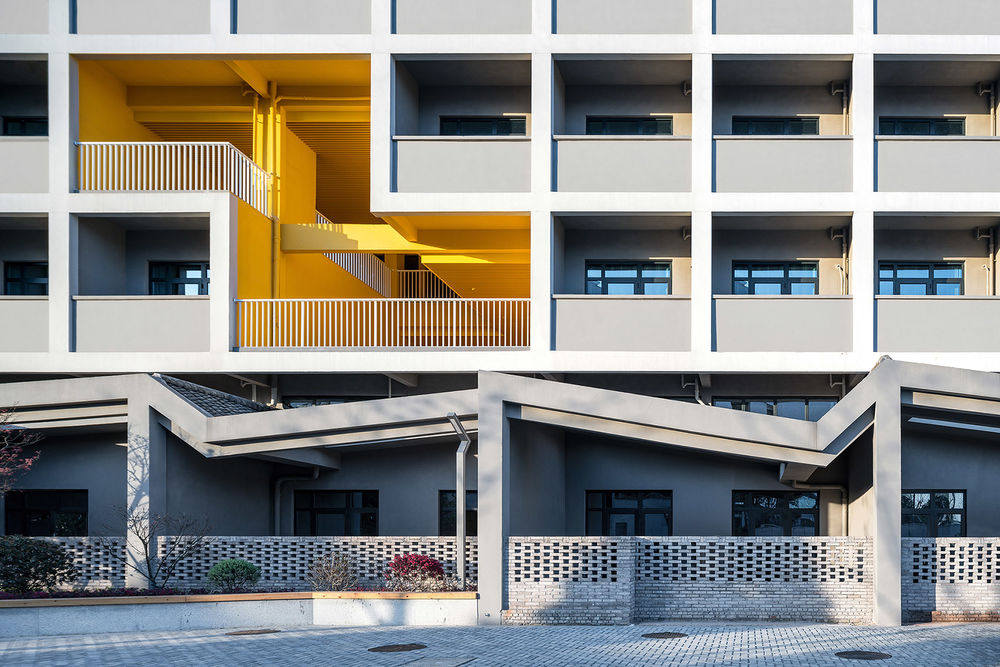
整个学校的概念策略、空间形态和场所定义描绘了一副全新生动的体验式教学图景,设计作为实现的媒介为义乌新世纪外国语学校的师生提供了更多的教育体验和可能性。而贯穿其中的设计聚焦点:教育类空间在城市高密度环境中的微妙立场、国际化教学体系与传统国学文化兼容并重的有机教学空间建筑空间、面向未来的传统空间体验营造,也是飞速城市化进程中的中国所普遍面临的问题,更是零壹城市一直以来并且会持续关注的高密度城市与教育空间问题的研究点。
A lively new experiential education scenario is sketched out by the design concept, the form and spatial definition. As the medium of realization, the design enriches educational experience and bring more possibilities for the teachers and students.
It’s a project with huge challenges. How to define the architectural form of educational building in the high-density urban environment. How architectural space meet the need for new teaching space type combined the international education system and traditional culture. How to create a traditional space experience for the future.
All of these issues are common questions in the process of rapid urbanization in China, and what LYCS have been focusing in the field of high-density city and education.
▼宿舍楼立面图,dormitory elevation
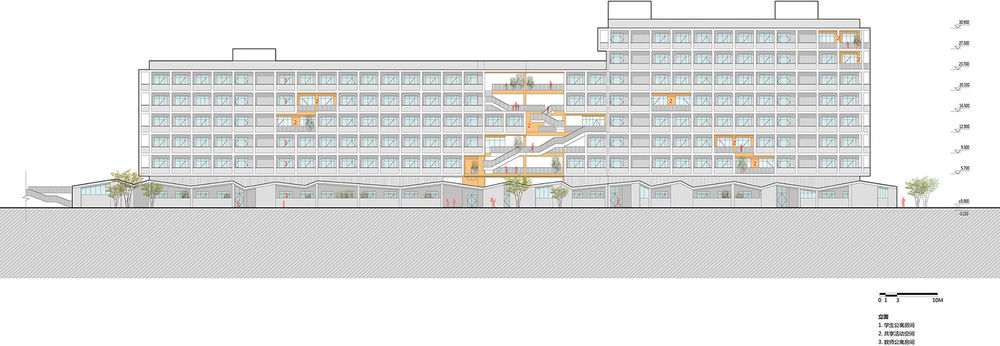
项目名称:义乌新世纪外国语学校 项目地点:中国 义乌 项目面积:85,481平方米 设计公司:零壹城市建筑事务所(建筑设计、室内设计、景观设计) 设计团队:阮昊、陈文彬、聂月亮、陈琪 参与人员:吴时阳、蒋蕾蕾、吴涛、陈志林、蔡泽宇、徐骏、杨舸、奚淑瑛、周晋 项目时间:2016-2018(设计+施工) 摄影师:吴清山
Project name: Yiwu Foreign Languages School Location: Yiwu, China Size: 85,481 sqm Design Firm: LYCS Architecture(Architecture, Interior and landscape Design) Project Team: RUAN Hao, CHEN Wenbin, NIE Yueliang, CHEN Qi Participants: WU Shiyang, JIANG Leilei, WU Tao, CHEN Zhilin, CAI Zeyu, XU Jun, YANG Ge, XI Shuying, ZHOU Jin Project Period: Design + Construction 2016-2018 Photographer: WU Qingshan
